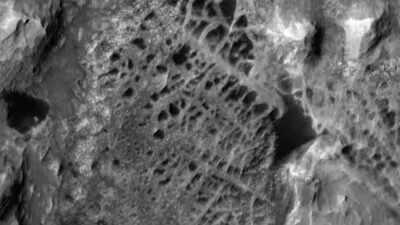Trending
What are spider webs on Mars that NASA’s Curiosity Rover might likely explore
Twelve years after landing on Mars, Curiosity Rover is investigating peculiar 'boxwork' formations on Mount Sharp. These giant spiderweb-like patterns, possibly formed by evaporating water, may hold clues to past microbial life, similar to Earth's cave formations. Scientists are intrigued by sulfur crystals found nearby, adding to the mystery.

Image Credit: X handle-@MarioNawfal
For the past year, NASA’s Curiosity rover has been exploring the Gediz Vallis channel on Mount Sharp within Gale Crater on Mars. During its investigations, the rover discovered stones embedded with pure sulfur crystals, a finding that has left the mission team intrigued and searching for answers about their origin and formation. Now Curiosity is on its way to an intriguing set of web-like patterns called boxwork. These patterns appear like giant spiderwebs or honeycombs, and scientists believe that they have been formed as the last remaining surface water in this part of Mars dried up.

Image Credit: X handle-@MarioNawfal
The boxwork is a striking geological formation composed of intersecting ridges that stretch across an area of 6 to 12 miles (10 to 20 km). From an aerial view, it resembles a massive spider web, though its origins are entirely geological, not the work of any real spiders. The true intrigue lies in whether biological processes played a role in shaping this unique structure.

How did these patterns come to be?
Such boxworks also exist on Earth, but they are typically seen in caves and on cliff faces. It is possible that microbes lived here billions of years ago, because microorganisms also thrived in similar situations on Earth.
End of Article
FOLLOW US ON SOCIAL MEDIA







